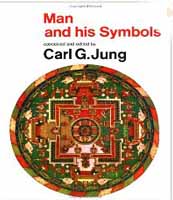Book: Man and His Symbols
When John Freeman of the BBC was filming “Face to Face” with Carl Jung and became aware of how invaluable his work was, he asked Jung if he
asked Jung if he had ever considered writing a book that expressed his ideas in a way the public might readily understand. Jung essentially replied that he was getting on in his years and he couldn’t do so. Than night He then had a dream of where he was delivering a paper to a crowd of blue-collar workers. He understood the dream to be a directive to create such a book. Thus, Man and His Symbols.
Jung wrote only the first section to the book: the other sections are written by prominent Jungian analysts, part of Jung’s inner circle: Marie Loiuse von Franz, Joseph L. Henderson, Jolande Jacobi, and Aniela Jaffe.
(Make sure you get the hardcover book with the pictures; the paperback copy does not have the image and thus does not convey the power of the work.)
Quotations from Man and His Symbols
Like the instincts, the collective thought patterns of the human mind are innate and inherited. They function, when the occasion arises, in more or less the same way in all of us.
…
Somewhere, right at the bottom of one’s own being, one generally does know where one should go and what one should do. (Marie Louise vonFranz)
…
Our psyche is somehow woven into the whole world, both outer and inner. All the higher manifestations of life are somehow tuned to the surrounding space-time continuum.
…
The ‘I Ching’ is based on the hypothesis of the Oneness of man and the surrounding cosmos. (Jolande Jacobi)
…
The circle (or sphere) is a symbol of the Self. It expresses the totality of the psyche in all its aspects, including the relationship between man and the whole of nature. Whether the symbol of the circle appears in primitive sun worship or modern religion, in myths or dreams, in the mandalas drawn by Tibetan monks, in the ground plans of cities, or in the spherical concepts of early astronomers, it always points to the single most vital aspect of life – its ultimate wholeness. (Aniela Jaffe)
…
The history of symbolism shows that everything can assume symbolic significance: natural objects (like stones, plants, animals, people, mountains and valleys, sun and moon, wind, water, and fire), or man-made things (like houses, boats, or cars), or even abstract forms (like numbers, or the triangle, the square, and the circle). In fact, the whole cosmos is a potential symbol . (Aniela Jaffe)
…
If a single individual devotes himself to individuation, he frequently has a positive contagious effect on the people around him. It is as if a spark leaps from one to another. And this usually occurs when one has no intention of influencing others and often when one uses no words. (Marie Louise vonFranz),
…
Like all the higher forms of life, man is in tune with the living beings around him to a remarkable degree. He perceives their sufferings and problems, their positive and negative attributes and values, instinctively – quite independently of his conscious thoughts about other people. (Marie Louise vonFranz)
…
Whenever a human being genuinely turns to the inner world and tries to know himself – not by ruminating about his subjective thoughts and feelings, but by following the expressions of his own objective nature such as dreams and genuine fantasies – then sooner or later the Self emerges. The ego will then find an inner power that contains all the possibilities of renewal . (Marie Louise vonFranz)
…
The organizing center from which the regulatory effect stems seems to be a sort of ‘nuclear atom’ in our psychic system. One could also call it the inventor, organizer, and source of dream images. Jung called this center the ‘Self’….Throughout the ages people have been intuitively aware of the existence of such an inner center. The Greeks called it man’s inner ‘daimon’; in Egypt it was expressed by the concept of the ‘Ba-soul’; and the Romans worshiped it as the ‘genius’ native to each individual. In more primitive societies it was often thought of as a protective spirit embodied within an animal or a fetish . (Marie Louise vonFranz)
…
Archetypes create myths, religions, and philosophies that influence and characterize whole nations and epochs of history.
…
They (the Archetypes) are, indeed, an instinctive trend, as marked as the impulse of birds to build nests, or ants to form organized colonies.
…
Myths of a religious nature can be interpreted as a sort of mental therapy for the sufferings and anxieties of mankind in general – hunger, war, disease, old age, death.
…
The very numbers you use in counting are more than you take them to be. They are at the same time mythological elements (for the Pythagoreans, they were even divine.)

